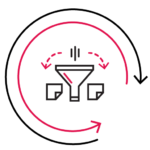Tech Team Augmentation — Why Consider it Right Now?
Traditionally, when an organization was growing or taking on a new project, and workforce expansion was necessary, the standard procedure was to:
- Determine the necessary qualifications, appropriate salary, and other details
- Create a job description and listing
- Advertise the open position(s)
- Review and cull applications
- Schedule and conduct one or more interviews with each qualified candidate
- Choose the candidate that seems to be the best fit
- Rinse and repeat until there’s no more need
There’s nothing inherently wrong with that process, and it’s worked adequately for generations. But, it has its drawbacks too, especially in today’s fast-paced, highly competitive tech marketplace:
- It’s time-consuming and labor-intensive
- It generally precedes a long and expensive onboarding and training process before the new hire is really up-to-speed and making the company money
- It’s not always easy to vet applicants effectively, so investing in the wrong person is just a cost of doing business
- It’s predicated on the assumption that every prospective employee is looking for a long-term position and will be loyal to the company
- Specific to tech positions (software developers, DevOps professionals, software architects, etc.) the tech talent gap has made finding qualified talent very difficult and retaining talent even harder
As a result, forward-thinking companies that understand the importance of moving quickly and prioritizing innovation are increasingly taking advantage of alternative talent acquisition strategies. One example is team augmentation.
What is team augmentation (and what is it not)?

This is different from other forms of talent acquisition in a few fundamental ways.
Team augmentation is not working with a staffing company
Generally, staffing and recruiting companies will take on the laborious task of sourcing, vetting, and recruiting candidates for a given position. Then, they will pass the individual off to the company’s HR department to handle as they would any other employee. The company is responsible for all onboarding, training, and logistics from there.
Team augmentation providers, on the other hand, provide specialized talent from their own vetted stable of qualified employees. Since the individuals work for the partner company, they handle all the behind-the-scenes logistics — legal requirements, documentation, taxes, payroll, benefits, etc. Rather than providing these individuals full-time and indefinitely, the partner company contracts their services for whatever hours (or days/weeks/months) are necessary to complete a given project or reach a business goal.
Team augmentation is not outsourcing all of a business unit’s services
While many organizations — especially small businesses and startups — can benefit from fully outsourcing business services like IT or Marketing, there are both pros and cons to doing so. The relative lack of direct control can be a significant challenge in some cases.
Unlike outsourcing companies that provide turn-key services for an entire business unit, team augmentation providers facilitate embedding team members directly into the client’s existing teams. This allows the client company to effectively direct and manage these team members as they would any other employee. It also supports a better cultural fit with the rest of the team and management.
Team augmentation is not hiring independent contractors
Now, more than ever, companies in all industries rely on independent contractors (aka freelancers) to handle tasks both large and small. While there are benefits to these arrangements, it’s notoriously difficult to find and retain freelancers with a truly high level of professionalism and the expertise necessary to consistently produce high-quality work.
Team augmentation partners are not simply locating and matching freelancers with client organizations. Rather, they are filling specific roles with experienced specialists who have already proven themselves in those areas. And, even if filling a specific niche role requires that they recruit a new team member of their own, it’s the team augmentation partner who is responsible for vetting and ensuring the team member’s qualifications and experience, not the client company.
What problems does tech team augmentation solve?

Here are some of the most often reported challenges that lead companies to consider tech team augmentation:
Difficulty finding the right talent for a reasonable cost
The old adage says, “it’s hard to find good help these days.” That’s definitely true in the IT industry, in part because of the ongoing (and accelerating) tech talent shortage. Qualified and experienced IT professionals are highly sought-after because the demand is far higher than the supply right now, and the gap is projected to double in size by 2030.
This situation has also resulted in software engineering and support positions becoming among the highest-paid jobs around. This is excellent for IT professionals, but not so much for companies that desperately need talent, but can’t always fit what they need into limited budgets.
Tech team augmentation services can often offer top talent at lower cost because they’re not limited to candidates near the client’s offices. Many of these companies take advantage of the latest in remote working technologies to source talent from across the globe, including lands where the hourly wages are much lower than they are in the U.S., U.K., and Australia, for example.
Additionally, reputable tech team augmentation services are wholly focused on finding and recruiting the best talent available and ensuring they are continually trained in the latest technologies so they can offer a world-class service to their clients. So, finding the perfect candidate for the client’s unique needs is almost guaranteed.
Difficulty retaining talent because of growing pressure and demands
For similar reasons, retaining qualified IT talent is also increasingly difficult. These highly sought-after IT professionals realize their worth, of course, so they’re understandably always looking for the next big opportunity. Again, this is great for them, but it means companies restrained by tight budgets or working in less-than-glamorous fields find their heavy investments in hiring and onboarding IT talent evaporate as employees leave and the process needs to start over again.
While tech team augmentation services are not immune to the turnover inherent in the modern IT job market, their full-time focus on bringing in top talent from around the world ensures the pipeline is always full, so they will be able to backfill necessary positions faster and more cost-effectively than client companies can.
Investing too much time, effort, and money into staffing
As noted above, the traditional hiring process is time- and labor-intensive. According to research from Workable, the worldwide average period to locate and hire an IT professional is 30 days. And that doesn’t include all the time, effort, and expense required in the onboarding and training stage. During all that time, the work isn’t getting done. According to the Society of Human Resources Management, the total cost of hiring and onboarding can be as much as 50 to 250 percent of the employee’s annual salary.
When working with a team augmentation partner, they are responsible for all the time, effort, and expense of finding, recruiting, and employing their tech talent. The client simply requests what they need and pays the flat fee for the time required.
Unable to keep up with a growing backlog of features

To some extent, every company is a software company today. And, if the software, networking, or cybersecurity work isn’t getting done, it results in customer dissatisfaction, internal process inefficiencies and lost productivity, lack of innovation, and potentially lost revenue.
The quick and efficient augmentation of the client’s IT team on a per-project basis offers the ability to ramp up as needed to chip away at a growing backlog. Then, if and when the need decreases, they are not left with an overstaffing problem. This translates to the best of both worlds: high-quality work with optimal flexibility.
When is team augmentation the smarter play?
Given the foregoing, organizations would want to consider tech team augmentation (as opposed to traditional hiring or other outsourcing options) especially under the following circumstances.
- One or more short-term, high-priority projects need to get done, and completing them on time is beyond the scope of the current IT staff.
- A project requires a particular set of skills the current IT staff does not possess. Or, existing team members who have the skills don’t have the experience to handle the workload efficiently with high-quality results.
- The company needs an increased staff to support a large-scale push to complete a particular project or meet a business goal, but does not expect to need the increased staff once the project is completed.
- The HR department is struggling to hire and onboard people fast enough or is having difficulty finding qualified candidates at a budget-friendly price.
If any of those scenarios describe your organization, contact Cprime today to discuss our tech team augmentation services.
In the next blog in this series, we’ll dive deeper into how to pursue tech team augmentation by choosing the right partner and preparing for the engagement.


